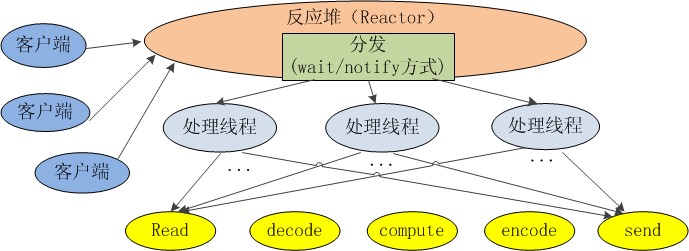Java NIO是在jdk1.4开始使用的,它既可以说成“新IO”,也可以说成非阻塞式I/O。下面是java NIO的工作原理:
-
由一个专门的线程来处理所有的IO事件,并负责分发。
-
事件驱动机制:事件到的时候触发,而不是同步的去监视事件。
-
线程通讯:线程之间通过wait,notify等方式通讯。保证每次上下文切换都是有意义的。减少无谓的线程切换。
阅读过一些资料之后,下面贴出我理解的java NIO的工作原理图:

注:每个线程的处理流程大概都是读取数据,解码,计算处理,编码,发送响应。
Java NIO的服务端只需启动一个专门的线程来处理所有的IO事件,这种通信模型是怎么实现的呢?呵呵,我们一起来探究它的奥秘吧。java NIO采用了双向通道(channel)进行数据传输,而不是单向流(stream),在通道上可以注册我们感兴趣的事件。一共有以下四种事件:
| 事件名 | 对应值 |
| 服务端接收客户端连接事件 | SelectionKey.OP_ACCEPT(16) |
| 客户端连接服务端事件 | SelectionKey.OP_CONNECT(8) |
| 读事件 | SelectionKey.OP_READ(1) |
| 写事件 | SelectionKey.OP_WRITE(4) |
服务端和客户端各自维护一个管理通道的对象,我们称之为selector,该对象能检测一个或多个通道(channel)上的事件。我们以服务端为例,如果服务端的selector上注册了读事件,某时刻客户端给服务端送了一些数据,阻塞I/O这时会调用read()方法阻塞地读取数据,而NIO的服务端会在selector中添加一个读事件。服务端的处理线程会轮询地访问selector,如果访问selector时发现有感兴趣的事件到达,则处理这些事件,如果没有感兴趣的事件到达,则处理线程会一直阻塞直到感兴趣的事件到达为止。下面是我理解的java NIO的通信模型示意图:

为了更好地理解java NIO,下面贴出服务端和客户端的简单代码实现:
服务端:
package nio;
import java.io.IOException;
import java.net.InetSocketAddress;
import java.nio.ByteBuffer;
import java.nio.channels.SelectionKey;
import java.nio.channels.Selector;
import java.nio.channels.ServerSocketChannel;
import java.nio.channels.SocketChannel;
import java.util.Iterator;
public class NIOServer {
//通道管理器
private Selector selector;
/*
* 获得一个ServerSocket通道,并对该通道做一些初始化工作
* @param port 绑定的端口号
* @throws IOException
*/
public void initServer(int port) throws IOException {
//获得一个ServerSocket通道
ServerSocketChannel serverChannel = ServerSocketChannel.open();
//设置通道为非阻塞
serverChannel.configureBlocking(false);
//将该通道对应的ServerSocket绑定到port端口
serverChannel.socket().bind(new InetSocketAddress(port));
//获得一个通道管理器
this.selector = Selector.open();
/*将通道管理器和该通道绑定,并为该通道注册SelectionKey.OP_ACCEPT事件,注册
*该事件后,当该事件到达时,selector.select()会返回,如果该事件没到达selector.select()
*会一直阻塞。
*/
serverChannel.register(selector, SelectionKey.OP_ACCEPT);
}
/*
* 采用轮询的方式监听selector上是否有需要处理的事件,如果有,则进行处理
* @throws IOException
*/
public void listen() throws IOException {
System.out.println("服务端启动成功!");
//轮询访问selector
while(true){
//当注册的事件到达时,方法返回;否则,该方法会一直阻塞
selector.select();
//获得selector中选中的项的迭代器,选中的项为注册的事件
Iterator ite = this.selector.selectedKeys().iterator();
while(ite.hasNext()){
SelectionKey key = (SelectionKey)ite.next();
//删除已选的key,以防重复处理
ite.remove();
//客户请求连接事件
if(key.isAcceptable()){
ServerSocketChannel server = (ServerSocketChannel)key.channel();
//获得和客户端连接的通道
SocketChannel channel = server.accept();
//设置成非阻塞
channel.configureBlocking(false);
//在这里可以给客户端发送信息哦
channel.write(ByteBuffer.wrap(new String("1234567890").getBytes()));
//在和客户端连接成功之后,为了可以接收到客户端的信息,需要给通道设置读权限
channel.register(this.selector, SelectionKey.OP_READ);
}else if(key.isReadable()){
read(key);
}
}
}
}
/*
* 处理读取客户端发来的信息的事件
* @param key
* @throws IOException
*/
public void read(SelectionKey key ) throws IOException{
//服务器可读取消息:得到事件发生的Socket通道
SocketChannel channel = (SocketChannel) key.channel();
//创建读取的缓冲区
ByteBuffer buffer = ByteBuffer.allocate(10);
channel.read(buffer);
byte[] data = buffer.array();
String msg = new String(data).trim();
System.out.println("服务端收到信息:" + msg);
ByteBuffer outBuffer = ByteBuffer.wrap(msg.getBytes());
channel.write(outBuffer);//将消息回送给客户端
}
public static void main(String[] args) throws IOException {
NIOServer server = new NIOServer();
server.initServer(8080);
server.listen();
}
}
客户端:
package nio;
import java.io.IOException;
import java.net.InetSocketAddress;
import java.nio.ByteBuffer;
import java.nio.channels.SelectionKey;
import java.nio.channels.Selector;
import java.nio.channels.SocketChannel;
import java.util.Iterator;
public class NIOClient {
//通道管理器
private Selector selector;
/*
* 获得一个Socket通道,并对该通道做一些初始化的工作
* @param ip,连接的服务器的ip
* @param port,连接的服务器的端口号
* @throws IOException
*/
public void initClient(String ip,int port) throws IOException{
//获得一个Socket通道
SocketChannel channel = SocketChannel.open();
//设置通道为非阻塞
channel.configureBlocking(false);
//获得一个通道管理器
this.selector = Selector.open();
/*客户端连接服务器,其实方法执行并没有实现连接,需要在listen()方法中
*调用channel.finishConnect()才能完成连接
*/
channel.connect(new InetSocketAddress(ip,port));
//将通道管理器和该通道绑定,并为该通道注册SelectionKey.OP_CONNECT事件
channel.register(this.selector, SelectionKey.OP_CONNECT);
}
/*
* 采用轮询的方式监听selector上是否有需要处理的事件,如果有,则进行处理。
* @throws IOException
*/
public void listen() throws IOException{
//轮询访问selector
while(true){
/*
* 选择一组可以进行I/O操作的事件,放在selector中,客户端的该方法不会阻塞,
* 这里和服务端的方法不一样,查看api注释可以知道,当至少一个通道被选中时,
* selector的wakeup方法被调用,方法返回,而对于客户端来说,通道一直是被选中的
*/
selector.select();
//获得selector中选中的项的迭代器
Iterator ite = this.selector.selectedKeys().iterator();
while(ite.hasNext()){
SelectionKey key = (SelectionKey) ite.next();
//删除已选的key,以防重复处理
ite.remove();
//连接事件发生
if(key.isConnectable()){
SocketChannel channel = (SocketChannel) key.channel();
//如果正在连接,则完成连接
if(channel.isConnectionPending()){
channel.finishConnect();
}
//设置成非阻塞
channel.configureBlocking(false);
//在这里可以给服务端发送信息哦
channel.write(ByteBuffer.wrap(new String("abcdefg").getBytes()));
//在和服务端连接成功之后,为了可以接收到服务端的信息,需要给通道设置读的权限
channel.register(this.selector, SelectionKey.OP_READ);
//获得了可读的事件
} else if(key.isReadable()){
read(key);
}
}
}
}
public void read(SelectionKey key) throws IOException{
SocketChannel channel = (SocketChannel) key.channel();
ByteBuffer buffer = ByteBuffer.allocate(10);
channel.read(buffer);
byte[] data = buffer.array();
String msg = new String(data).trim();
System.out.println("客户端收到信息:" + msg);
ByteBuffer outBuffer = ByteBuffer.wrap(msg.getBytes());
channel.write(outBuffer);
}
public static void main(String[] args) throws IOException{
NIOClient client = new NIOClient();
client.initClient("localhost", 8080);
client.listen();
}
}
